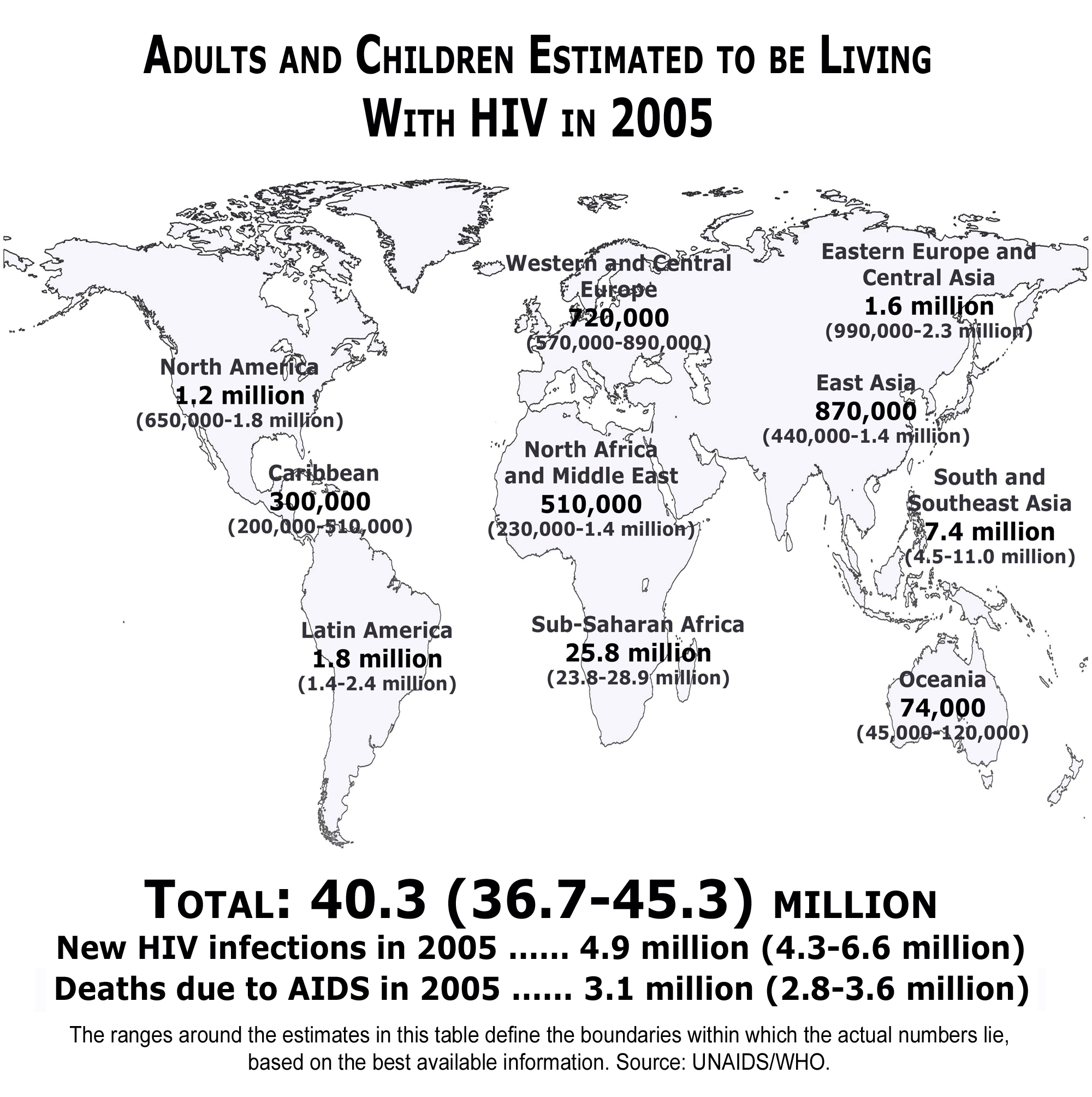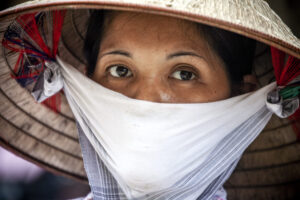
GENEVA, Switzerland (BP)–An estimated 2.5 million people contracted the virus that causes AIDS last year, bringing the total number of people in the world living with HIV/AIDS to 33.2 million, according to UNAIDS, the joint United Nations program on HIV/AIDS.
Also, an estimated 2.1 million individuals died from AIDS in 2007, based on the best available information released in a report by UNAIDS and the World Health Organization Nov. 20.
Of the more than 30 million people living with HIV/AIDS, 2.5 million are children, UNAIDS reported in its global summary of the AIDS epidemic. More than 25 million people have died of AIDS since 1981, UNAIDS said, and Africa has 12 million AIDS orphans.
The UNAIDS report drew attention mostly because it contained numbers indicating United Nations scientists have long overestimated both the size and course of the AIDS epidemic, The Washington Post said.
Estimates released in November showed a more than 40 percent reduction in the number of new infections and a 21 percent reduction in the number of people living with HIV/AIDS compared to last year’s figures. UNAIDS attributes the change to better methodology rather than a substantial shift in the epidemic, The Post reported.
SUB-SAHARAN AFRICA
More than two-thirds, or 68 percent, of all people living with HIV are in Sub-Saharan Africa, UNAIDS said. Of the estimated 22.5 million suffering from the virus in that region, about 1.7 million became infected in 2007 — more than in all other regions of the world combined. The 1.7 million AIDS deaths in Sub-Saharan Africa represent 76 percent of global AIDS deaths this year, the U.N. agency said.
Unlike other regions, the majority of people, 61 percent, living with HIV in Sub-Saharan Africa are women. Female prevalence is higher in the region because of male-to-female HIV transmission through unprotected sex and the younger age at initial infection for women.
Worldwide, heterosexual transmission of HIVAIDS results primarily from risky behavior, including unprotected sex with an intravenous drug user or a woman having unprotected sex with a man who has sex with other men.
NORTH AFRICA AND MIDDLE EAST
About 35,000 people became infected with HIV in North Africa and the Middle East this year, bringing the total number living with the virus to 380,000. AIDS killed an estimated 25,000 in the region, and most reported infections were in men, UNAIDS said.
The most-at-risk groups in the region are injection drug users, sex workers and homosexual men, and UNAIDS said a lack of adequate HIV reporting makes analyzing the epidemic more challenging there. Data shows that localized HIV epidemics exist across the region, while a generalized epidemic persists in Sudan, the agency said.
SOUTH AND SOUTHEAST ASIA
An estimated 4 million people are living with HIV in South and Southeast Asia this year, including the 340,000 people who became newly infected, UNAIDS said. About 270,000 individuals died from AIDS-related illnesses, and the number of people receiving antiretroviral therapy increased more than threefold since 2003, reaching an estimated 235,000 by June 2006.
UNAIDS said the latter number represents about 16 percent of the total number of people in need of antiretroviral treatment in Asia, and only Thailand has succeeded in providing treatment to at least 50 percent of the people needing it.
It is estimated that just under half of all people living with HIV in China in 2006 were infected while injecting drugs with contaminated equipment, UNAIDS said, while a similar proportion acquired the virus during unprotected sex.
EAST ASIA
The number of people living with HIV in East Asia in 2007 was an estimated 800,000 million, UNAIDS said. New infections surfaced in 92,000 people, and in 2007 there were almost 20 percent more new HIV infections in East Asia than in 2001, the agency reported.
Almost one-third of newly diagnosed HIV infections in the region were in people 15 to 24 years old. In China, those most at risk are injection drug users and those who buy or sell sex, UNAIDS said, and in Japan, the most at risk are homosexual men.
OCEANIA
An estimated 14,000 people acquired HIV in Oceania in 2007, bringing the number of people living with the virus to 75,000. Nearly three-quarters of those people are in Papua New Guinea, where unsafe heterosexual intercourse is estimated to be the main mode of HIV transmission, UNAIDS said, adding that “the HIV epidemic in Papua New Guinea continues to expand, amid a plethora of risk factors that could promote further growth unless prevention efforts are stepped up quickly.”
In Australia and New Zealand, HIV continues to be transmitted mainly through unprotected sex between men, UNAIDS said.
LATIN AMERICA
Although the patterns of the HIV epidemic are changing in some Latin American countries, the epidemic in the region overall remains stable, with new HIV infections totaling about 100,000 and 58,000 people dying of AIDS in 2007, UNAIDS said.
Two-thirds of the estimated 1.6 million people living with HIV in Latin America live in the four largest countries: Argentina, Brazil, Colombia and Mexico, UNAIDS said, and outbreaks of HIV are occurring mainly among injection drug users and homosexual men in South America.
Widespread poverty and migration as well as insufficient information about epidemic trends outside major urban areas is contributing to the spread of HIV in Latin America, UNAIDS said. HIV transmission continues to occur among populations at higher risk of exposure, including sex workers and men who have sex with men.
CARIBBEAN
Nearly three-quarters of the 230,000 people living with HIV in the Caribbean are in the Dominican Republic and Haiti, but national adult HIV prevalence is high throughout the region with Cuba being the exception.
Overall, an estimated 17,000 people became infected with HIV this year in the Caribbean, UNAIDS said, adding that “although HIV infection levels have remained stable in the Dominican Republic and have declined in urban parts of Haiti, more localized trends suggest that both countries need to guard against possibly resurgent epidemics.”
About 11,000 people died of AIDS in the Caribbean in 2007, making the disease one of the leading causes of death among adults aged 25 to 44 years.
The primary mode of HIV transmission in this region is sexual intercourse, UNAIDS said, with unprotected sex between sex workers and clients a significant factor in the transmission of HIV.
EASTERN EUROPE AND CENTRAL ASIA
The number of people living with HIV in Eastern Europe and Central Asia rose this year to 1.6 million, including the 150,000 people who became newly infected largely through injection drug use, UNAIDS said. About 55,000 individuals died from AIDS-related illnesses.
The majority of youth with HIV live in the Russian Federation and Ukraine which, together, account for about 90 percent of all people living with HIV in the region, UNAIDS reported. Uzbekistan now has the largest epidemic in Central Asia.
Of the new HIV cases reported in 2006 in Eastern Europe and Central Asia for which there was information on the mode of transmission, UNAIDS said nearly two-thirds were attributed to injecting drug use and more than one-third were ascribed to unprotected heterosexual sex.
WESTERN AND CENTRAL EUROPE
Antiretroviral therapy has helped increase the number of people living with HIV in Western and Central Europe, UNAIDS said. Overall, about 760,000 people are living with AIDS in the region in 2007, including 31,000 who acquired HIV this year. Comparatively few people died of AIDS, the agency said, noting that the number was around 12,000 this year.
Heterosexually-acquired HIV infections, most of which were among immigrants and migrants, accounted for 42 percent of new HIV diagnoses in Western Europe in 2006 while 29 percent of newly diagnosed HIV infections were attributable to unsafe sex between men, and 6 percent to injection drug use.
Injection drug use is the most-reported mode of HIV transmission in the three Baltic states — Estonia, Latvia and Lithuania — where the epidemics appear to have stabilized in Central Europe.
NORTH AMERICA
An estimated 1.3 million people in America are living with AIDS in America, with 46,000 new cases this year. The number of deaths in 2007 was estimated at 21,000. Worldwide, only seven countries are estimated to have more people living with HIV than the United States, UNAIDS said.
In the U.S., more than half of all newly diagnosed HIV infections in 2005 were among men who have sex with men. People exposed to HIV through heterosexual intercourse with a non-regular partner accounted for just under one-third of newly diagnosed HIV infections and AIDS cases, while about 18 percent occurred among injection drug users, UNAIDS reported.
–30–
Compiled by Erin Roach, Baptist Press staff writer.















